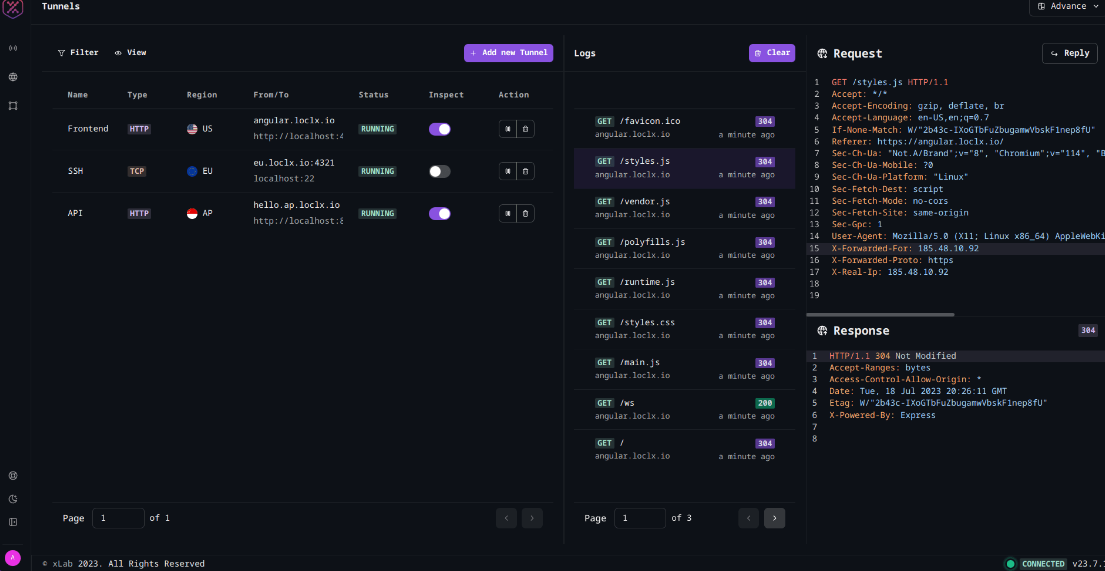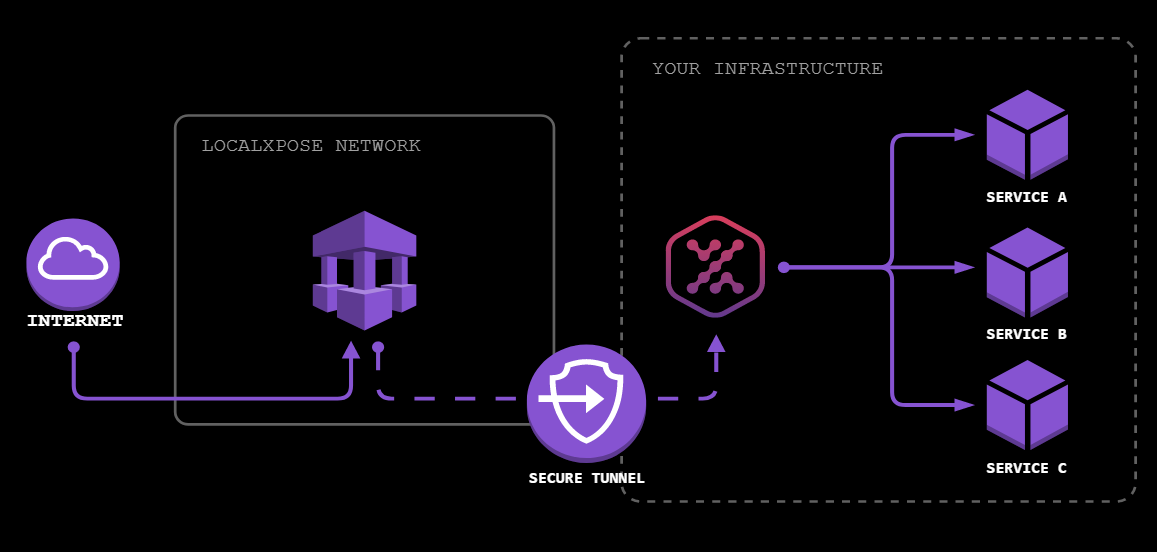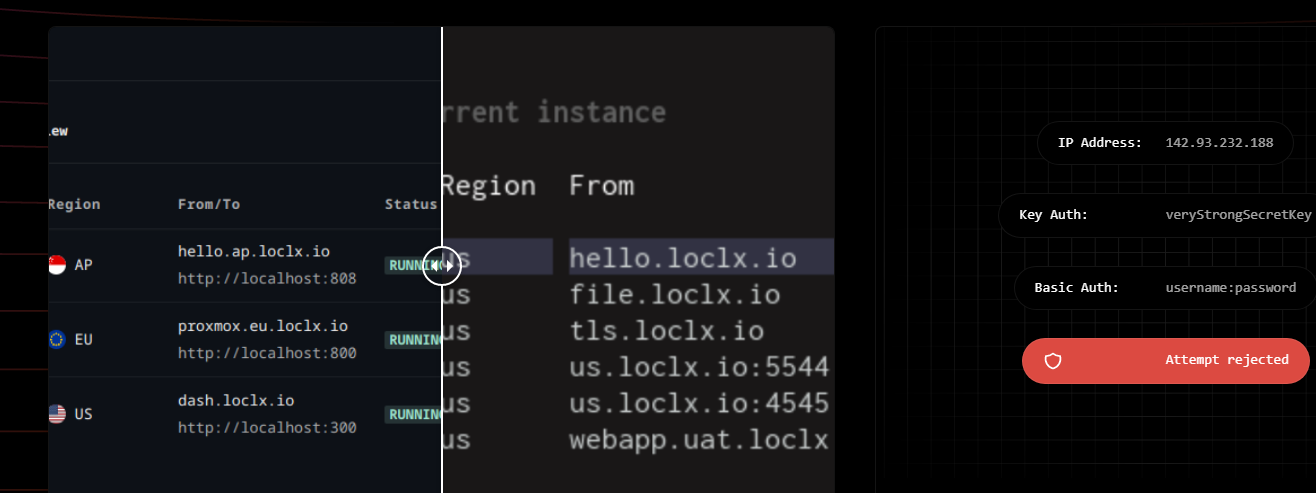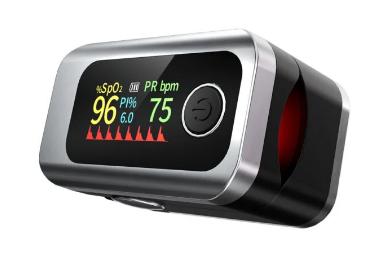LocalXpose
Today we will be making a recommendation about LocalXpose, a cutting-edge platform designed to expose local servers to the internet. For developers working with webhooks, HTTP services, or other web services, this tool is invaluable, enabling seamless interaction with external networks.
LocalXpose enhances security by creating secure tunnels, allowing developers to expose a local server to the internet safely. This protects sensitive data and applications from unauthorized access and potential cyber threats.
LocalXpose offers the option of creating custom subdomains, which is vital for developers who wish to maintain brand consistency and professionalism while using the service.
One of LocalXpose’s significant advantages is its user-friendly interface, making it accessible even to novice developers or those new to network exposure tools. The platform offers straightforward setup procedures, intuitive controls, and clear guidelines, reducing the learning curve and enabling users to focus more on development and less on configuration.
See below some of the best features of LocalXpose.
LocalXpose API Development

LocalXpose is predominantly used in web development for testing and debugging purposes. It allows developers to expose their local web server to the internet, making it accessible for user testing, client demonstrations, or third-party integrations.
Given that webhooks require a publicly accessible URL to receive payloads, LocalXpose is indispensable for developers in testing webhook integrations by exposing locally hosted endpoints to external services.
Developers leverage LocalXpose when developing APIs, as it enables external applications to interact with the API during the development phase, allowing for thorough testing and validation.
LocalXpose Secure Tunnel

In a digital landscape marked by escalating security concerns, LocalXpose prioritizes user safety. It employs advanced encryption standards and secure tunnels to safeguard data transmission, and also offers features like password protection for added layers of security. These mechanisms are pivotal in ensuring the integrity and confidentiality of the user’s data and applications.
LocalXpose User-Friendly Interface

One of LocalXpose’s significant advantages is its user-friendly interface, making it accessible even to novice developers or those new to network exposure tools. The platform offers straightforward setup procedures, intuitive controls, and clear guidelines, reducing the learning curve and enabling users to focus more on development and less on configuration.
CLI and GUI Versions

LocalXpose: Diving into CLI and GUI Versions LocalXpose stands out by offering two interfaces: a Command Line Interface (CLI) and a Graphical User Interface (GUI), catering to different user preferences and needs. These two interfaces allow users to select the approach that aligns best with their comfort levels, technical proficiencies, and specific project requirements.
. Command Line Interface (CLI) For users who prefer a text-based interface, LocalXpose’s CLI version provides a powerful and flexible environment. This interface is especially favored by developers who are accustomed to terminal-based operations and scripting.
Advantages of CLI: Speed: For experienced users, CLI enables quicker interactions and executions, streamlining the workflow.
Scripting and Automation: CLI allows for the automation of repetitive tasks through scripts, enhancing productivity.
Resource Efficiency: Operating in a text-only mode consumes fewer system resources compared to graphical interfaces.
Applications: The CLI version is ideal for system administrators and developers who need to integrate LocalXpose into scripted workflows or automated tasks. It is suited for environments that lack a graphical desktop, like certain servers or minimal installation setups.
Graphical User Interface (GUI) The GUI version of LocalXpose is designed with a focus on visual interaction, making it intuitive and user-friendly. It’s a suitable choice for those who prefer interacting with software through graphical icons, windows, and buttons.
The GUI version is preferable for users who value ease of use and visual feedback, including those new to network exposure tools. It is apt for tasks that benefit from real-time visual representations, like monitoring traffic and inspecting requests and responses.
Advanced access control

LocalXpose strides ahead in its sector with its feature-rich offering, one of which is its Advanced Access Control. This feature, integral for managing permissions meticulously, allows users to implement a series of controls to secure tunnel access effectively.
Multiple Authentication Methods: Advanced Access Control in LocalXpose provides diverse authentication methods like IP authentication, Basic Authentication, and Key Authentication, to name a few. IP Authentication: This method grants access based on the user’s IP address, ensuring that only users from specific IP addresses can access the tunnel.
It’s particularly effective for restricting access to a certain location or network. Basic Authentication: Involves the utilization of usernames and passwords, adding a layer of security that requires users to authenticate themselves before gaining access.
Key Authentication: This technique leverages unique keys for access, ensuring that only users possessing the correct key can access the tunnel.
Empowering User Security: LocalXpose empowers users by allowing them to use their own TLS certificates for end-to-end encryption. This ensures that the data transmitted through the tunnels remains confidential and secure from unauthorized access or cyber threats.
To subscribe to LocalXpose just click the link below.






